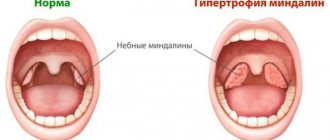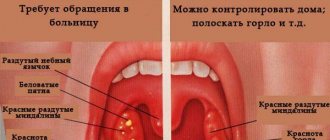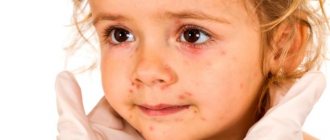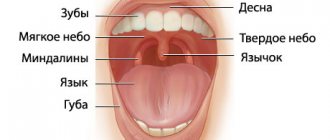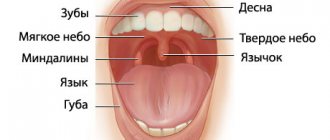Enlarged tonsils in a child may indicate that the body is fighting some kind of infectious carrier, or some other pathologies. With this symptom, it is necessary to treat the underlying pathology in the body.
Author:
- Oganesyan Tigran Sergeevich
ENT pathology expert
4.10 (Votes: 10)
Tonsils (tonsils) are a collection of lymphoepithelial tissue, which is the point of contact of the immune system with the external environment. Thanks to this, the body produces protective immunoglobulin proteins in response to bacteria, viruses, fungi and other foreign microorganisms. Thus, the formation and maturation of immunity occurs. Located at the border of the respiratory and digestive tracts, the tonsils promptly intercept viruses and bacteria that enter the body with inhaled air, water and food.
Enlarged tonsils in a child are not a separate disease. They say:
- that the body is fighting some kind of infectious carrier;
- about genetically determined proliferation of lymphoepithelial tissue without an infectious agent;
- about possible blood diseases (oncohematological diseases), autoimmune diseases and diseases of the endocrine system.
The problem is that tonsil hypertrophy progresses quickly, and it is important not to miss the moment when the painful condition begins to cause severe discomfort to the child, but to treat the underlying pathology in a timely manner. Only an experienced doctor, whose specialization is children's ENT diseases, can correctly determine the true factor in the appearance of the symptom and choose competent therapy to eliminate it.
Mechanism of disease development
Acute laryngitis is an inflammation of the mucous membrane of the larynx. The larynx is located in the front region of the neck. It connects the pharynx to the trachea and performs three vital functions:
- sound-producing (the vocal apparatus is located in it);
- respiratory;
- protective (prevents food and foreign particles from entering the trachea).
Under the influence of a number of factors (hypothermia, overstrain of the vocal cords, allergies, infectious diseases, etc.), the mucous membrane of the child’s larynx becomes inflamed. As a result, a sharp dilation of blood vessels occurs, edema develops, the lumen of the glottis narrows (or completely closes), speech function is impaired and breathing becomes difficult.
Chronic tonsillitis as a consequence of loose tonsils
Hypertrophy of the tonsils is a consequence of repeated respiratory infections, pharyngitis, and tonsillitis. The tonsils increase in size, and the number of lacunae in which food gets stuck and purulent contents accumulate also increases. If a sore throat is not treated, the child will very soon develop chronic tonsillitis, which every now and then develops into a sore throat. This may eventually lead to the removal of the tonsils.
Symptoms of chronic tonsillitis
Chronic tonsillitis is a slowly smoldering infection in the throat. The disease occurs as a result of untimely and incorrectly treated sore throat. With this disease, the tonsils cease to reliably protect the body, and they themselves quickly become involved in the pathological process. Its symptoms:
- periodic soreness in the throat;
- low-grade fever up to 37.5C;
- purulent plugs on the tonsils;
- general malaise and weakness;
- hyperemia and swelling of the larynx;
- white coating on the tongue;
- slight headache;
- enlarged lymph nodes.
Symptoms of a sore throat
A sluggish inflammatory process in a loose throat can at any time turn into an acute stage and end with a sore throat. Most often this happens when the child’s local immunity decreases, he is in an infectious environment and in rooms with dry air. In acute tonsillitis, the following symptoms are observed:
- severe pain in the throat, making it impossible to swallow;
- elevated temperature up to 39.5C;
- huge inflamed tonsils that almost completely cover the entrance to the trachea;
- purulent plugs on the tonsils;
- general weakness.
The acute stage of tonsillitis can only be cured with antibiotics. You can be treated without them, but then full recovery will not occur earlier than in two weeks, and this threatens complications and is dangerous for the child.
Complications after a sore throat
If you initially approach the treatment of sore throat incorrectly, it can result in rheumatism and heart problems. The fact is that the immune system begins to produce antibodies against streptococci, which are often the causative agents of bacterial tonsillitis.
The immune system recognizes the work of the heart muscle and musculoskeletal system as an invasion of pathogenic bacteria and begins to fight against them. That is why people who suffer from chronic tonsillitis often develop diseases of the urinary, reproductive and cardiovascular systems of the body. They are also more susceptible to rheumatoid arthritis.
Treatment of sore throat
The biggest mistake in treating a sore throat and sore throat, which both parents and doctors make, is prescribing broad-spectrum antibiotics without understanding the cause of the disease. Meanwhile, sore throat can be caused by several types of pathogens:
- fungi;
- herpes virus;
- bacteria.
Treatment with antibiotics for fungal and herpes sore throat will not bring any results. In addition, such therapy can further worsen the disease. Prolonged sore throat is the main cause of a loose throat and, as a consequence, chronic tonsillitis. This is why medications can be prescribed after receiving the results of a throat smear.
Incorrect and untimely treatment of sore throat is the main cause of loose tonsils in children.
A loose and red throat, as a consequence of acute tonsillitis, is treated depending on the cause that contributed to the manifestation of such symptoms:
- viral tonsillitis - antiviral drugs;
- fungal tonsillitis - antifungal agents;
- bacterial - antibiotics.
In all of the above cases, frequent rinsing and dissolving tablets to relieve pain are indicated as auxiliary therapy..
Causes of acute laryngitis in children
In order for assistance to a child with acute laryngitis to be as effective as possible, you must first find out what caused the development of the disease. The main provoking factors include:
- ARVI, influenza;
- bacterial respiratory tract infections caused by pneumococcus, staphylococcus, streptococcus, hemophilus influenzae;
- complications after scarlet fever, measles;
- inflammation of the paranasal sinuses;
- local/general hypothermia of the body;
- inhalation of cold, smoky air;
- congenital weakened resistance of the respiratory tract;
- unfavorable environmental conditions;
- contact with allergens;
- uncontrolled use of sprays and aerosols for the throat, leading to a reflex spasm of the larynx in a child;
- overstrain of the vocal cords (strong screaming, loud singing);
- infectious diseases of the oral cavity;
- stress factors.
How to cure tonsillitis
If a loose throat is a consequence of a chronic inflammatory process, this is not a death sentence at all. Modern medicine has new methods for treating tonsillitis, and some of them have proven to be very effective.
- Vacuuming is the suction of purulent contents from the lacunae of the tonsils. After the procedure, the throat is treated with an antiseptic solution with an antibiotic.
- Washing the tonsils. The procedure is carried out with a 100 ml syringe, with which the otolaryngologist treats loose tonsils with an antiseptic solution.
- Ultraviolet, laser therapy and ultrasound are local disinfecting effects on the tonsils.
The above physiotherapeutic procedures are a chance to cure and preserve tonsils. If left untreated, tonsillitis can become a direct indication for their removal. Vacuuming has proven to be the most effective. The duration of treatment is 1.5-2 months.
Surgery is a last resort. Today, doctors advocate preserving the tonsils, even if the child has a loose throat and suffers from sore throats. However, if tonsillitis takes an acute form 3-4 times a year, the tonsils have to be cut out.
Obviously, loose tonsils in a child are not a reason to panic, but parents should make every effort to prevent this condition from developing into chronic tonsillitis. Sanitation of the oral cavity and larynx, rinsing and taking appropriate medications to strengthen the baby’s local immunity will help cope with this problem. If you take all preventive measures and follow the recommendations of the otolaryngologist, your throat will be healthy.
Symptoms of acute laryngitis
In childhood, acute laryngitis develops quite rapidly. At an early stage of the disease caused by a virus, the child experiences:
- general weakness,
- nasal congestion,
- soreness,
- redness of the throat,
- painful swallowing.
In some cases, body temperature may rise to 38–39°C.
Further added to the above symptoms are:
- rhinorrhea (excessive mucus discharge from the nasal passages);
- dry barking cough;
- hoarseness or complete loss of voice.
Over time, during intensive complex treatment of laryngitis, the cough becomes more rare and productive, that is, accompanied by the discharge of sputum.
Complications of acute laryngitis in children
One of the most dangerous complications of acute infectious laryngitis, characteristic of early and preschool childhood, is stenosis (narrowing of the lumen) of the larynx. It is also called false croup or acute airway obstruction. This complication may be due to the structural features of the child’s respiratory tract. Most often it develops against the background of influenza, parainfluenza, adenovirus, measles infection or chickenpox.
When the space under the vocal cords swells, the lumen of the larynx narrows, acute obstruction of the airways occurs, and oxygen deficiency develops. Symptoms of laryngeal stenosis are:
- heavy wheezing,
- barking cough
- hoarseness or complete loss of voice,
- excessive excitement of the child,
- enlarged lymph nodes,
- increase in body temperature,
- the appearance of light dry wheezing.
If you notice these symptoms, you should immediately consult a doctor. But it’s better not to let this happen and start treating acute laryngitis on time.
Causes of pathology
The infection is caused by group A streptococcus. A person can be either a carrier of the pathogen or an active source of infection. The greatest contagiousness is observed in the first 1-4 days of the acute period. 3 weeks after the onset of the disease, the likelihood of the infection spreading is reduced to zero. Up to 20% of the adult population are asymptomatic carriers of streptococcus. There is a seasonal dependence: the largest number of infections is recorded in the autumn-winter period against the background of acute respiratory viral infections, tonsillitis, and pneumonia.
Diagnosis of the disease
Diagnosis of acute laryngitis is not particularly difficult. The diagnosis is based on the presence of acute respiratory infections symptoms, as well as hoarseness, shortness of breath, and barking cough. Call a doctor: he will listen to complaints, examine the child, measure the temperature, listen to the lungs and make a diagnosis.
Non-drug therapy
Treatment of acute laryngitis depends on the age of the child. This may include:
- compliance with bed rest;
- limiting vocal load (for 5–7 days it is better for the baby to remain silent or talk as little as possible);
- maintaining the optimal temperature (+18…+20°C) and air humidity (50–70%) in the room where the sick child is located;
- drink plenty of fortified drinks (the liquid should be warm and unsweetened);
- following a hypoallergenic diet - if there are symptoms of laryngitis, it is strictly not recommended for a child to give sour, spicy, too hot or cold foods and carbonated drinks.
When treating inflammation of the mucous membrane of the larynx, children are allowed to apply wet and dry warming compresses to the neck area and gargle with a warm infusion/decoction of chamomile or sage, if recommended by a doctor.
Loose throat: pathology or not
A child's sore throat is not a diagnosis, but rather a condition. This is an excess of lymphoid tissue on the tonsils and on the back of the throat. Enlarged tonsils are a favorable environment for the proliferation of pathogenic organisms .
If such a phenomenon does not bother the child, then preventive measures will be sufficient. If at the same time there is hyperemia of the larynx and increased temperature, this indicates that an inflammatory process has occurred. The first degree of hypertrophy of the tonsils in a child does not mean that he will have problems with his throat in the future. It is not at all necessary that this is precisely the cause of frequent illnesses and that everything will soon end in chronic tonsillitis. Sometimes otolaryngologists see no reason for concern if the baby has a loose throat. The reasons are as follows:
- loose tonsils and the back wall of the throat can be a consequence of frequent illnesses, however, if the child’s local immunity has been restored and is at a high level, then this sign does not indicate any pathology;
- Enlarged tonsils may return to normal over time, as the child grows and the amount of lymphoid tissue in the body may change. The prognosis is especially favorable if the baby stops getting sick often, in particular with sore throats and pharyngitis.
Doctors emphasize the need to strengthen local immunity and harden the throat. Placing a child at home, wrapping him up and not letting him go outside is a fundamentally wrong approach in this case.
As the child gets older, the tonsil problem may go away on its own or develop into a chronic condition. That is why it is not recommended to ignore a loose throat. Even if the baby easily tolerates infections, and colds do not result in complications, it is necessary to sanitize the tonsils and treat a red throat at the slightest inflammation.
Drug therapy
How to fight infection?
Drug therapy for laryngitis that appears in a child against the background of an acute respiratory infection includes the use of antiviral and immunomodulatory drugs.
Antihistamines, which are usually prescribed for allergies, help relieve swelling of the mucous membrane and calm the baby. They should be given before bedtime, strictly according to the recommendation of the attending physician. What to do if you have a cough?
Remedies for this symptom are another essential component of treatment.
In the early stages of laryngitis, if a child has a dry hacking cough, drugs that block the cough center are used. Next, at the first signs of coughing, mucolytics are prescribed to thin the mucus and improve expectoration of sputum. Doctor MOM® cough syrup has similar properties. This complex herbal medicine, containing extracts of 10 medicinal plants, helps not only to liquefy mucus, but also to relieve swelling and inflammation. Herbal syrup is approved for long-term use in the treatment of laryngitis in children over 3 years of age. Actions at temperature.
If a child has a hard time tolerating a high temperature, he is prescribed an antipyretic. Treatment of laryngitis with antibiotics is justified only in the presence of serious bacterial complications and only as prescribed by a doctor.
How to treat a child's sore throat
We are all accustomed to brushing our teeth twice a day, because this is the key to their health. However, isn’t it necessary to take care of the health of the nasopharynx as a whole, because bacteria multiply not only between the teeth, but also on the tongue and in the throat. Loose tonsils are a favorable environment for the growth of bacteria, so keeping them clean is no less important than keeping the mouth clean.
The first rule is rinsing
The child should be taught to gargle as early as possible.
This is not easy, but clean tonsils are the key to strong immunity and its health in the future. There is no need to buy newfangled medications: ready-made commercial sprays or rinses are far from the most effective remedies for a sore throat. The most effective antiseptic is regular table or sea salt . It is saline solutions that are the best:
- moisturize mucous membranes;
- kill bacteria;
- relieve inflammation.
Just pour warm water into a glass, add a teaspoon of salt, a teaspoon of soda and a couple of drops of iodine - this is the best remedy for treating a sore throat. When the throat is inflamed, this recipe can be adjusted by adding one aspirin tablet to the water - this will improve blood flow to the diseased organ.
When a child has a loose, but not red throat, this does not mean that he does not need to be treated and wait until the problem gets worse. Teach your child to gargle after eating. This will prevent food particles from getting into the lacunae of the tonsils and turning into pus.
Solutions and lozenges
The basic rule for choosing lozenges and rinsing solutions: these preparations must be plant-based.
There are a lot of tablets for sore throats in pharmacies. This is exactly what you need to pay special attention to when choosing a medicine. Pain cannot be treated, it is relieved, but it is the sore throat that needs to be treated! Many drugs simply relieve pain and discomfort, but the problem of loose tonsils remains. Doctors recommend paying attention to the composition of medications. If there is a large amount of lidocaine and a minimum of plant extracts (for example, Decathylene, Hexalize, Orasept), such products are not suitable for treating a sore throat. If the composition of the tablets is more natural and natural, this is the best remedy for combating tonsillitis and loose tonsils. Lisobakt, Tonsillotren, Trachisan tablets, rinses and Tantum Verde lozenges performed well.

